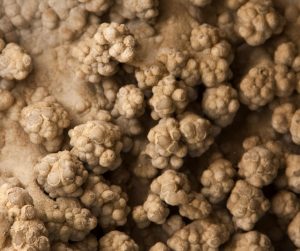
Have you heard of popcorn rock — growing popcorn out of a hard, gray rock? It’s hard to believe but you can grow crystals that look much like fluffy white kernels fresh from the popcorn popper.

I first ran across this amazing rock at a gem show. A supplier of educational specimens had gray rocks packaged under the label Popcorn Rock. I’ve seen similar packages labeled Bubble Rock. I’ve found popcorn rock packages at gems shows, rock shops and stores selling educational supplies for teachers.
Growing Popcorn Rock: Easy Instructions
- You start by purchasing the rock. The one I bought cost $5. Typically these are a type of dolomite or limestone rock.
- Remove the rock from its bag and place it in a small glass bowl.
- Pour just enough distilled white vinegar (acetic acid) to cover the rock. Bubbles will immediately fizz out, and once that happens, your duties are complete.
- Put the bowl in a warm place and then sit back and wait patiently for the vinegar to evaporate in one or two weeks.

While waiting, don’t disturb or move the bowl. In a day or two, you’ll see little white crystals sprout like tiny staghorn corals. You may be tempted to pick up the bowl for a closer look but resist. At this stage, the crystals are delicate and can easily be dislodged from their tenuous toehold.
Once all vinegar has evaporated, the final result is a dead ringer for freshly mined aragonite. Your crystals will be dendritic (branching) and/or acicular (needle-like). The needles will appear tightly clustered and look like puffy white popcorn pieces, hence the commercial name.
When found in caves, such specimens are technically called anthodites but are more commonly known as “cave flowers.” Let your sample dry completely before lifting it from the bowl. You’ll have a homemade mineral that, with care in handling, can grace the natural crystals in your collection.

Unexpected Discovery
Like many great discoveries, popcorn rock came to the public by accident. As the story goes, a University of Utah geology student Richard Barnes had collected fossil corals in 1981 in what he thought was a limestone (calcium carbonate) matrix. He followed a common procedure of placing his specimens in a bowl of acetic acid to free the fossils. This process normally dissolves limestone and leaves behind silicified fossils. But Barnes returned to find aragonite crystals growing from the rock.
Instead of limestone, his fossils were encased in a unique type of dolomite (calcium magnesium carbonate). Not all dolomite will produce such popcorn rock crystals, so there must have been something unique about that particular deposit’s chemistry.
If you visit YouTube and search for the term “popcorn rock,” you’ll find many videos demonstrating how to grow aragonite crystals. Be sure to keep an eye out for time-lapse videos that show crystal growth of two weeks in a mere 30-second video.
This article about popcorn rock previously appeared in Rock & Gem magazine. Click here to subscribe. Story by Jim Brace-Thompson.













